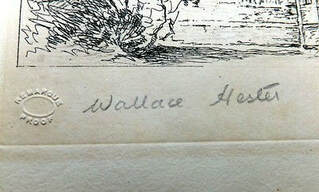Christ and Pilate (Ecce Homo)
|
Research by Marjorie Gregson
|

ENGRAVER
Robert Wallace Hester was a British artist, engraver and caricaturist of some renown. He created many witty illustrations of famous people for Vanity Fair. There are 54 of his portraits in the National Gallery. His father, Edward Gilbert Hester, was an engraver working in Chiswick, and there he taught his son the art of engraving.Robert often used abbreviations and pseudonyms to sign his work: W. Hester, Hester, WH. He exhibited at the Salon des Artiste Francais in Paris from 1905. REFERENCES www.askart.com/Robert_Wallace_Hester www.npg.org.uk Benezit Dictionary of British Graphic Artists and Illustrators. |
Acc No 190
Artist Munkácsy, Mihály 1844-1900 Engraver Hester, R Wallace 1866-1942 Medium engraving, framed Size unknown Donor Mary Alice Hindle, 67 Laverton Road, Lytham St Annes Date donated 26 March 1956 ORIGINAL PAINTING by Mihaly Munkacsy 1844-1900 Munkacsy was born Mihaly Lieb in Munkacs, Hungary. He officially began using the surname Munkacsy in 1868. Although born into a middle class family, one of five children, their mother died when he was six and his father, a government official, when he was eight. His early years were spent in poverty, working essentially as slave labour for various carpenters, working fourteen hours at day for little money. In 1860, after becoming seriously ill due to the privations of his earlier life, he returned into the care of his uncle, who, noticing the boy’s superb drawing ability, apprenticed him to a portrait painter, Elek Szamossy (1826-1888) thus beginning Mihaly’s formal training and broadening his knowledge of history, literature and mythology. He was granted access to copy masterworks at the National Museum in Pest, an experience that accelerated his artistic development. After training in Budapest, Munich and Dusseldorf, he lived mainly in Paris By the age of 26 he became a sensation with his first masterpiece The Last Day of a Condemned Man, inspired by the plight of young men caught evading the military draft, which won a gold medal at the at the Paris Salon in 1870. Munkascy then went on to achieve an international reputation with his genre paintings and large scale biblical pictures. His association with Charles Sedelmeyer, an Austrian dealer, assured his financial success. Mihaly’s life was to lead from one of abject poverty to meteoric superstardom and his stunning works hang in many great museums. His most famous masterpiece is known collectively as The Christ Trilogy: Christ Before Pilate (1881), Golgotha (1884) and Ecce Homo (1896), the latter took 6 years to complete. The paintings “enthralled the public with their massive scale and psychological insight”. Throughout his life Munkacsy worked under enormous pressure which would appear to have taken its toll on his mental health. He died in a mental home in Bonn, Germany in 1900. REFERENCES https:// musings-on-art.org www.mihalimunkacsy.org |

